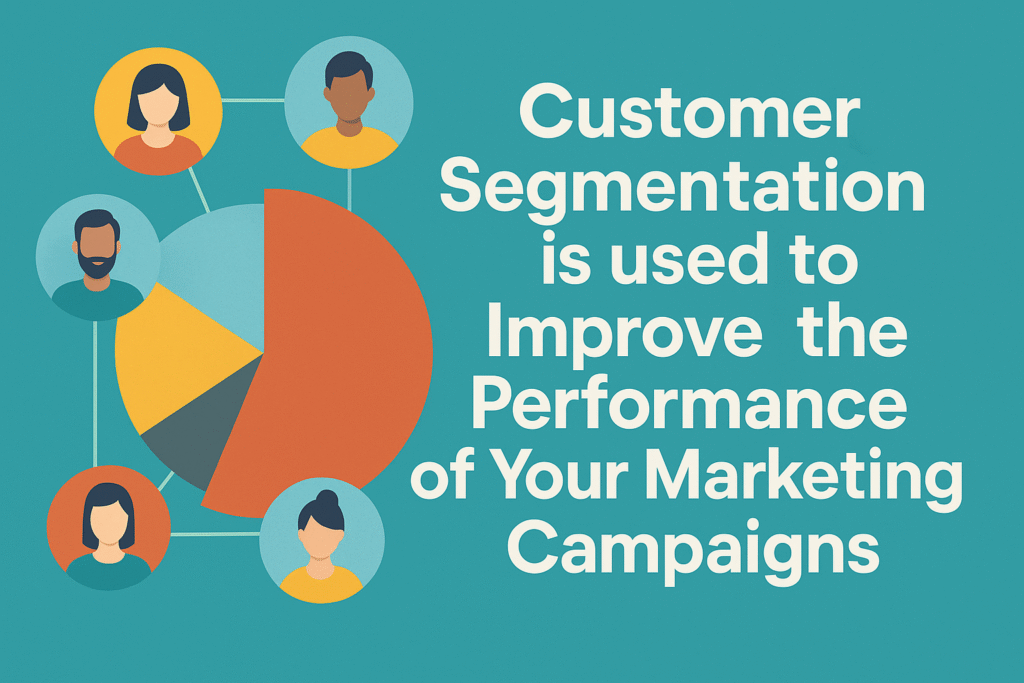Customer segmentation is the process of dividing customers into groups. This allows a company to treat each group differently, which improves customer satisfaction and loyalty. It can also help companies identify opportunities for new products or services based on specific customer needs. For example, a company may choose to target its advertising efforts toward certain groups of customers because those customers are more likely to buy certain products than others. In this article, we’ll cover what customer segmentation is and how you can use it to improve your marketing campaigns.

What is customer segmentation?
Definition.
Modeling.
Model.
Types of customer segments.
Examples.
Customer segmentation can be used to improve the performance of your marketing campaign.
Watch Erica Olsen discuss “Customer Segmentation Strategy: Where to play? (Growth Strategy)”
The process of dividing customers into groups with similar characteristics is known as customer segmentation. A successful marketing campaign will target the specific segments most likely to be interested in your product, thus maximizing returns on your advertising investment.
A company that sells software for use in the automotive industry can target one group of potential customers by making its website easy to navigate, while another group might prefer a more technical approach with detailed explanations and technical illustrations. This allows both types of customers to find what they want quickly and efficiently, increasing conversions for each type of visitor.
Customer segmentation is using data to understand who your customers are and how they behave. With this knowledge, you can create more targeted marketing campaigns that speak directly to each of these specific groups.
When you use customer segmentation, you’re able to:

Once you’ve identified the segments, it’s time to create a segmentation model. This is the process of assigning customers to one or more segments based on their characteristics or behavior.
The simplest way to create a segmentation model is by assigning each customer an identifier, such as their email address, and then classifying them based on the value(s) associated with that identifier. For example, if all customers who purchased something from your store had an email address ending in “@example.com”, then you could first use an email address as a means of grouping together all customers who have purchased from your store before (and perhaps also those who haven’t). Then once you’ve done this, you can apply whatever other criteria you want when determining which segments will receive specific messaging based on who they are and what they have done with regard to their past purchases at your store.
Once we’ve created our segmentation model, it’s important that we evaluate its performance so that we know whether or not what we believe about our market really holds true when applied through our campaign targeting efforts.
Customer segmentation is the process of dividing your customers into groups based on shared characteristics. What are these characteristics? Google Customer Segmentation Model

Watch Steven Hobe discuss “How to use Market Segmentation? Explained & Examples”
Here are some examples of customer segmentation:
Customer segmentation is the process of dividing a market into different groups of buyers. By dividing your customers into different segments, you can figure out more about them and how they buy. Segmentation allows you to get a better understanding of what appeals to each customer, which will help you improve the performance of your marketing campaigns.
For example, imagine that you’re selling a new brand of soap that comes in five different scents: lavender, eucalyptus mint, rosemary mint, bay laurel essential oils (LMEB), cucumber melon fragrance oil (CMFO), and honey almond scent (HAS). You could create two or three segments for this product: one for fans who have tried all five scents; another for those who prefer LMEB over all other scents; another group might prefer CMFO over any other scent; while yet another group would just like HAS because they love honey almond cookies.
A: Customer segmentation is the process of dividing a broader customer base into smaller, more homogeneous groups based on shared characteristics—such as demographics, behaviors, needs, or psychographics—so that marketing efforts can be tailored to each group. In the context of better marketing planning, segmentation allows you to:
Identify precise needs and pain points for each group (e.g., frequent purchasers vs. one-time buyers).
Develop targeted value propositions (e.g., messaging that resonates with young urban professionals vs. retirees).
Optimize channels and creative (e.g., social-media ads for millennials, email newsletters for busy parents).
Measure results and ROI by comparing performance across segments, then reallocating budget to the highest-impact audiences.
A: The four most common segmentation categories are:
Demographic Segmentation
Definition: Groups based on age, gender, income, education level, marital status, etc.
Marketing Benefit: Enables budget allocation toward demographics most likely to convert (e.g., targeting high-income brackets for premium products).
Psychographic Segmentation
Definition: Groups based on values, attitudes, interests, lifestyles, or personality traits.
Marketing Benefit: Helps craft emotionally resonant messaging (e.g., eco-friendly appeals to sustainability-minded segments).
Behavioral Segmentation
Definition: Groups based on actual behavior patterns—purchase history, product usage, brand loyalty, or decision-making criteria.
Marketing Benefit: Allows for timely, behavior-triggered communications (e.g., retargeting abandoned carts or rewarding loyal customers).
Geographic Segmentation
Definition: Groups based on physical location—region, country, city, or even micro-location (neighborhood).
Marketing Benefit: Facilitates location-specific offers and localization of content (e.g., promoting region-specific promotions or local events).
By layering these four types—often called “the 4 Ps of segmentation”—you can pinpoint highly specific niches, tailor your messaging, and allocate your ad spend far more efficiently than broad-brush campaigns.
A: A systematic approach to segmentation ensures consistency and maximizes ROI. The seven recommended steps are:
Define Objectives & Scope
Action: Clarify why you’re segmenting (e.g., increase conversion rates, reduce customer acquisition costs, launch a new product).
Outcome: A precise segmentation brief tied to business KPIs (e.g., “Identify 2–3 high-value segments for our new subscription offering by Q3”).
Gather & Analyze Data
Action: Collect quantitative and qualitative data: CRM records, web analytics, purchase histories, surveys, social listening.
Outcome: A unified data set that shows baseline behaviors, demographics, psychographics, etc.
Select Segmentation Variables
Action: Choose the most relevant variables (e.g., age + income for consumer electronics; firm size + industry for B2B).
Outcome: A shortlist of criteria that align with your marketing objectives (e.g., “User engagement level” to identify heavy vs. light users).
Cluster Customers into Segments
Action: Use statistical methods (e.g., K-means clustering, decision trees) or simple rule-based grouping to form distinct segments.
Outcome: A clear list of segment definitions (e.g., Segment A: “High-income, eco-conscious urban millennials”).
Profile & Validate Segments
Action: Create detailed profiles for each cluster: demographic summary, behavioral patterns, average CLV, key pain points.
Outcome: Confirmation that each segment is sizable, reachable, and sufficiently different from others (the classic “Measurable, Accessible, Substantial, Differentiable” criteria).
Develop Targeting & Positioning Strategies
Action: For each prioritized segment, decide on:
Messaging pillars
Campaign channels (e.g., Instagram, email, programmatic display)
Offer structure (e.g., discount tiers, bundles, content themes)
Outcome: A mini-brief for each segment—“how we speak, where we speak, and what we offer.”
Implement, Monitor & Optimize
Action: Launch campaigns, track KPIs per segment (CTR, conversion rate, AOV, ROI), gather feedback, and iterate.
Outcome: Continuous improvement loops that let you reallocate budget to the highest-performing segments or refine criteria for underperforming ones.
Completing these steps creates a living segmentation model you can revisit quarterly or whenever market conditions shift.
A: Customer segmentation is critical because it:
Boosts Relevance & Engagement: By speaking each segment’s language and addressing unique needs, your marketing feels personalized rather than generic.
Improves Conversion Rates: Highly targeted offers tend to outperform one-size-fits-all promotions—reducing CPC and boosting ROI.
Optimizes Resource Allocation: Instead of spreading budget thinly, you concentrate on high-value pockets (e.g., high-LTV customers, frequent purchasers).
Enhances Product Development: Segmentation insights reveal unmet needs (e.g., a segment that prefers eco-friendly packaging), guiding R&D and next-generation offerings.
Supports Lifecycle Marketing: You can map each segment to a stage in the customer journey—acquisition, activation, retention, advocacy—and deploy the right tactics.
In short, segmentation transforms scattershot tactics into a surgical approach that maximizes relevance, profitability, and customer loyalty.
A: The main purpose of segmentation is to group customers in ways that improve marketing efficiency and effectiveness. More specifically, segmentation aims to:
Identify distinct audiences whose behaviors and preferences differ meaningfully.
Tailor campaigns and messaging so that each segment receives the most appropriate content and offers.
Allocate budget and resources to the highest-impact segments, avoiding waste on low-potential groups.
Enable accurate measurement by tracking KPIs (e.g., conversion rate, average order value) at the segment level rather than as a whole, thus revealing which audiences move the needle.
Inform strategic decisions such as product roadmap adjustments, pricing strategies, and distribution channels based on segment priorities.
Ultimately, segmentation’s core purpose is to drive better marketing ROI by ensuring that every dollar is spent on the right person, with the right message, at the right time.
A: “Key customer segment” refers to the one (or few) segments that offer the highest strategic value based on criteria such as:
Revenue Potential (High LTV):
Segments whose average lifetime value outweighs acquisition cost—e.g., enterprise clients in a B2B SaaS business.
Growth Trajectory:
Emerging segments with rapid adoption curves—e.g., new urban millennials embracing a direct-to-consumer subscription model.
Brand Affinity & Advocacy:
Segments that not only buy but also refer peers—e.g., superfans who frequently share user-generated content.
Cost Efficiency:
Segments where CAC is relatively low because they self-educate or respond well to organic channels—e.g., community groups on Facebook or Reddit.
Choosing your “key” segment(s) is not just about who is spending the most now—it’s also about which audience is most likely to deliver sustainable, profitable growth. From a planning perspective, once you identify your key segment, 70–80% of your top-level strategy (messaging, positioning, channel mix) is guided by that segment’s characteristics.
A: While there are many benefits, the single most important is improved marketing ROI through relevance. By zeroing in on a segment’s unique needs:
Click-through rates (CTR) increase, because your creative and copy speak directly to that group.
Conversion rates climb, since your offer mirrors their purchase triggers.
Customer acquisition costs drop, as you avoid casting a wide net on uninterested prospects.
Customer lifetime value (CLV) often rises, because satisfied, well-served segments tend to repurchase and refer others.
In summary, the key benefit of segmentation is that it turns generic tactics into highly focused, measurable campaigns that multiply ROI by aligning your value proposition with each audience’s distinct profile.
A: The principal requirement is data accuracy and richness—in other words, you need reliable, granular data that allows you to:
Identify meaningful distinctions (e.g., difference in purchase frequency between Segment A and Segment B).
Measure segment size and potential (e.g., total addressable market within each group).
Validate accessibility (e.g., whether you can actually reach that segment through your channels).
Specifically, effective segmentation hinges on:
Measurability: You must be able to quantify each segment’s size and behavior.
Relevance: Variables chosen (demographic, psychographic, behavioral, geographic) must tie back to how those customers buy or use your product.
Accessibility: The segment must be contactable—either through paid media, organic channels, or direct outreach.
Actionability: You need the capability to customize marketing mix (message, creative, offer) for that segment.
Without quality data—accurate CRM fields, up-to-date web analytics, clean third-party insights—segmentation becomes guesswork. In turn, you lose the ability to plan campaigns that truly resonate or measure their impact effectively.
A: Segmentation is beneficial because it:
Drives Personalization at Scale: Rather than sending one generic ad, you craft multiple versions tailored to different groups, significantly lifting engagement.
Enhances Customer Satisfaction & Loyalty: When customers feel understood (e.g., receiving relevant promos or content), they’re more likely to stick around.
Increases Upsell & Cross-sell Opportunities: By understanding segment-specific behaviors, you can recommend relevant add-ons—e.g., a “high-usage” segment receives discounted upgrade offers.
Stimulates Innovation & Product Fit: Insights from distinct groups often reveal new features or sub-brands that resonate—helping you expand your product line thoughtfully.
Reduces Waste: Both in ad spend (fewer wasted impressions) and creative production (focusing on content that truly moves each segment).
All of these benefits add up to stronger unit economics, better budget utilization, and ultimately a healthier bottom line.
A: At its core, segmentation is about recognizing that “not all customers are created equal.” The concept involves:
Breaking Down a Large Audience into Smaller Homogeneous Groups
Instead of treating all customers as a monolith, you identify subgroups with shared traits that influence their buying decisions.
Customizing Marketing Mix Elements (4Ps) for Each Group
Product: Feature variations, package sizes, or service levels that align with segment preferences.
Price: Tiered pricing or discount structures based on segment willingness to pay.
Place: Distribution channels (e.g., e-commerce vs. brick-and-mortar) that segments prefer.
Promotion: Messaging, creative, and channel choices matched to how each group consumes information.
Driving More Efficient Resource Allocation
By investing in segments with the highest strategic value (e.g., profitability, growth potential), you maximize ROI.
Continuously Refining Your Understanding
Segmentation is not a one-and-done exercise—it’s an iterative process where data is re-examined, segments are re-scored, and strategies are tweaked.
The concept of segmentation is the foundation upon which all high-performance marketing strategies are built: it ensures you’re speaking to “the right person with the right message at the right time.”
A: While marketing encompasses a wide range of activities, the primary goal—from a segmentation standpoint—is to align your offerings to the exact needs and desires of each segment in order to generate profitable customer actions. More specifically:
Create Awareness & Interest among the most relevant segments.
Drive Consideration & Preference by demonstrating how your solution uniquely solves each group’s pain points.
Facilitate Conversion with tailored offers, optimized funnels, and urgency triggers that speak to each segment’s motivations.
Build Loyalty & Advocacy by nurturing post-purchase relationships with segment-specific content, loyalty programs, or community-building efforts.
In essence, the primary goal of marketing is to generate a chain of positive customer experiences—starting from the very first impression—so that higher profitability and sustained growth follow naturally. Segmentation is the mechanism that ensures you never waste marketing resources on uninterested or less profitable audiences.
A: Once segments are defined, you must choose how broadly or narrowly to target them. The four classic strategies are:
Undifferentiated (Mass) Targeting
Approach: One offer/messaging to everyone.
When to Use: Commodity or low-involvement products where individual differences are minimal (e.g., basic household supplies).
Downside: Low relevance can lead to poor engagement and higher wasted spend.
Differentiated (Segmented) Targeting
Approach: Tailor multiple marketing mixes to two or more distinct segments (e.g., separate campaigns for “price-sensitive families” vs. “premium single professionals”).
When to Use: You have the budget and capacity to customize creative, offers, and channels.
Benefit: Higher relevance + better ROI per segment, although at the cost of increased complexity.
Concentrated (Niche) Targeting
Approach: Devote all resources to a single, well-defined segment (e.g., ultra-luxury SUVs marketed exclusively to high-net-worth individuals in major metropolitan areas).
When to Use: When one segment clearly outperforms all others in terms of lifetime value or brand fit.
Benefit: Deep penetration and brand authority within that niche, often leading to higher loyalty.
Micromarketing (Individual) Targeting
Approach: Hyper-personalized campaigns at the individual or very small group level—enabled by advanced data analytics and automation.
When to Use: When you have the data infrastructure to support personalization (e.g., 1:1 email flows, behavior-triggered ads).
Benefit: Maximum relevance and minimal waste, but high cost and resource requirements.
Selecting one of these four strategies depends on your brand’s resources, data maturity, and overall marketing objectives. For example, a startup with limited budget may choose a concentrated strategy—focusing on its single highest-potential segment—before scaling to a differentiated approach.
Customer segmentation is a great way to improve the effectiveness of your marketing campaigns, but it can be tricky to get right. If that sounds like something that might be useful for you, we’d love to help! Our team has worked with a wide range of different businesses and would be happy to sit down with you for an initial consultation about how we can work together. We’re always available at [info@digitsmarketer.com], or feel free to reach out via phone or text at (+20) 112-9999-068 if there’s anything else we can do now!
Transforming businesses through innovative digital marketing strategies.
About Us
Case Studies
Careers
Contact
© 2025 Digits Marketer. All rights reserved.
WhatsApp us